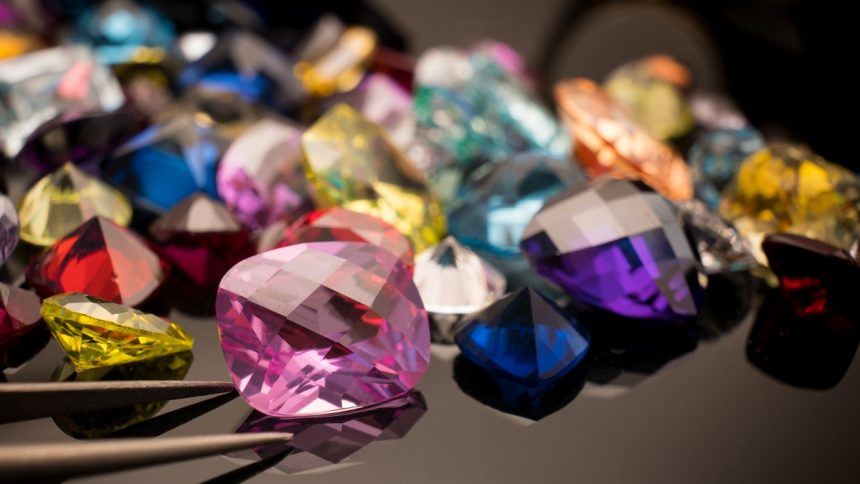Gemstones have fascinated people for centuries, not only for their beauty but also for their enduring value. What starts as a rough stone deep within the earth is transformed into stunning pieces of jewelry, often becoming cherished family heirlooms passed down through generations.
But the journey of a gemstone from its origin to becoming a priceless piece of jewelry is a long and meticulous process.
The Origin of Gemstones: From Deep Within the Earth
How Gemstones Are Formed
Gemstones are formed deep within the earth through natural geological processes that take millions of years. Under intense heat and pressure, minerals crystallize into the beautiful stones we know as diamonds, emeralds, sapphires, rubies, and more. Each type of gemstone forms under specific conditions, contributing to the wide variety of colors, sizes, and properties seen in gemstones today.
For instance, diamonds are formed from carbon under extreme pressure, while emeralds are made from beryllium, aluminum, and chromium. The unique environmental factors during their formation are what give each gemstone its distinct characteristics.
Major Gemstone Mining Locations
Different gemstones are mined from various regions around the world, with each location contributing to the rarity and quality of the gems it produces. For example, diamonds are famously sourced from South Africa and Botswana, while sapphires come from Sri Lanka and Thailand. Colombia is known for producing some of the world’s finest emeralds.
The geographic origin of a gemstone often adds to its value. For instance, a pink diamond from the Argyle mine or a blue sapphire from Kashmir can command higher prices due to the region’s reputation for high-quality stones.
The Mining Process
Gemstones are extracted from the earth through mining, which can be done using traditional methods or modern machinery. Some stones are found in alluvial deposits, where gemstones are sifted from riverbeds, while others require deep mining in tunnels and open pits.
Ethical mining practices are becoming increasingly important, with more consumers looking for sustainably sourced gemstones that minimize environmental impact and support local communities. Certifications like the Kimberley Process ensure that diamonds are conflict-free, which adds to their appeal as an investment and heirloom.
Sorting and Grading: Evaluating the Quality of Raw Gemstones
Sorting Rough Gemstones
Once gemstones are mined, they go through a sorting process where experts examine the rough stones for quality and potential value. This initial sorting looks at factors like color, clarity, and size to determine which stones are worth cutting and polishing.
High-quality rough gemstones are sent to be transformed into polished gems, while lower-quality stones may be used for industrial purposes or discarded. The value of a gemstone often begins with this first step in the process.
Gemstone Grading Systems
After sorting, gemstones are graded using established systems by organizations like the Gemological Institute of America (GIA). For diamonds, the 4 Cs—Cut, Color, Clarity, and Carat weight—are used to evaluate the quality and value of each stone.
Other gemstones, like sapphires and emeralds, have their own grading standards, but color remains one of the most important factors. A certified gemstone with a high grade is more valuable in the market and becomes a stronger candidate for a future heirloom.
The Role of Ethical Sourcing and Certifications
With growing consumer awareness, ethical sourcing has become a crucial factor in the gemstone industry. Certifications like the Kimberley Process for diamonds and Fair Trade Gemstones for colored stones ensure that the gems have been mined responsibly and are conflict-free.
When investing in gemstones, especially for heirlooms, it’s essential to look for certified, ethically sourced gems. These certifications not only ensure that the gemstone is genuine but also increase its long-term value.
Transforming Rough Stones into Polished Gems: The Art of Cutting and Polishing
The Lapidary Process: Cutting the Gemstone
After grading, rough gemstones are sent to a lapidary—an expert in cutting and polishing gems. The lapidary’s job is to maximize the beauty and value of the gemstone by cutting it in a way that enhances its brilliance and reveals its best qualities.
For example, a round brilliant cut is often chosen for diamonds to maximize their sparkle, while an emerald cut emphasizes the clarity of emeralds. The cut of a gemstone significantly impacts its final value and aesthetic appeal.
Polishing for Perfection
Once a gemstone has been cut, it is polished to bring out its shine and luster. The polishing process is crucial for achieving the final look of the gemstone, making it ready for setting in jewelry. A well-polished gemstone will reflect light beautifully, adding to its desirability and market value.
The Impact of the Cut on Gemstone Value
The cut of a gemstone can greatly influence its market price. A well-cut gemstone will be more brilliant and visually appealing, while a poorly cut stone may appear dull. For instance, a pink diamond with an expertly executed cut will fetch a much higher price than one that hasn’t been cut to optimize its beauty.
From Polished Gemstone to Jewelry: Creating a Priceless Heirloom
The Jewelry Design Process
Once the gemstone is polished, it is ready to be set in jewelry. Jewelers design pieces that highlight the beauty of the gemstone while also ensuring it is securely held in place. Popular settings include prong, bezel, and halo settings, each chosen to suit the gemstone’s size, cut, and color.
Choosing the Right Metal
The choice of metal for the jewelry piece—whether gold, platinum, or silver—also impacts the overall value of the heirloom. Precious metals like gold and platinum not only complement the gemstone’s appearance but also add intrinsic value to the piece.
Crafting the Final Piece
The final step in the gemstone’s journey is turning it into a finished piece of jewelry. Skilled craftsmanship is essential to ensure that the piece is both beautiful and durable. Well-crafted jewelry can last for generations, making it a perfect candidate for becoming a family heirloom.
The journey of a gemstone from mine to market is a fascinating process that transforms a rough stone into a priceless heirloom. Whether it’s a pink diamond or a deep blue sapphire, gemstones hold both emotional and financial value that can last for generations.
By understanding the steps involved in this transformation, you can appreciate the intricate process that makes gemstones timeless treasures.
Lynn Martelli is an editor at Readability. She received her MFA in Creative Writing from Antioch University and has worked as an editor for over 10 years. Lynn has edited a wide variety of books, including fiction, non-fiction, memoirs, and more. In her free time, Lynn enjoys reading, writing, and spending time with her family and friends.















